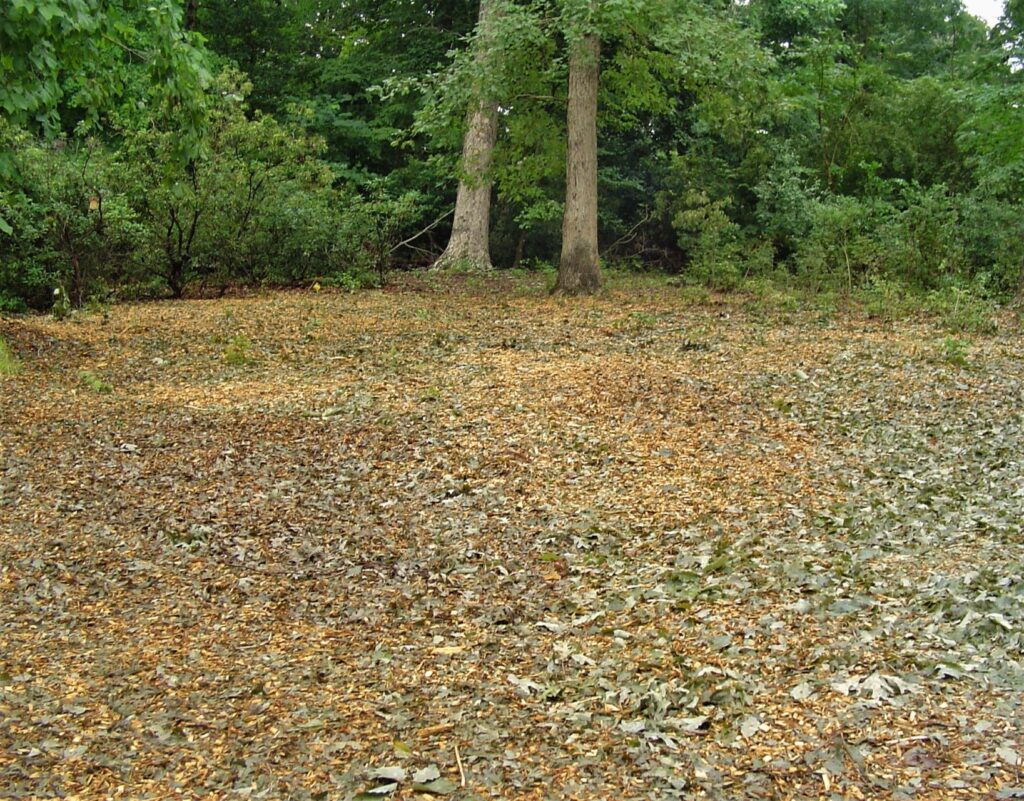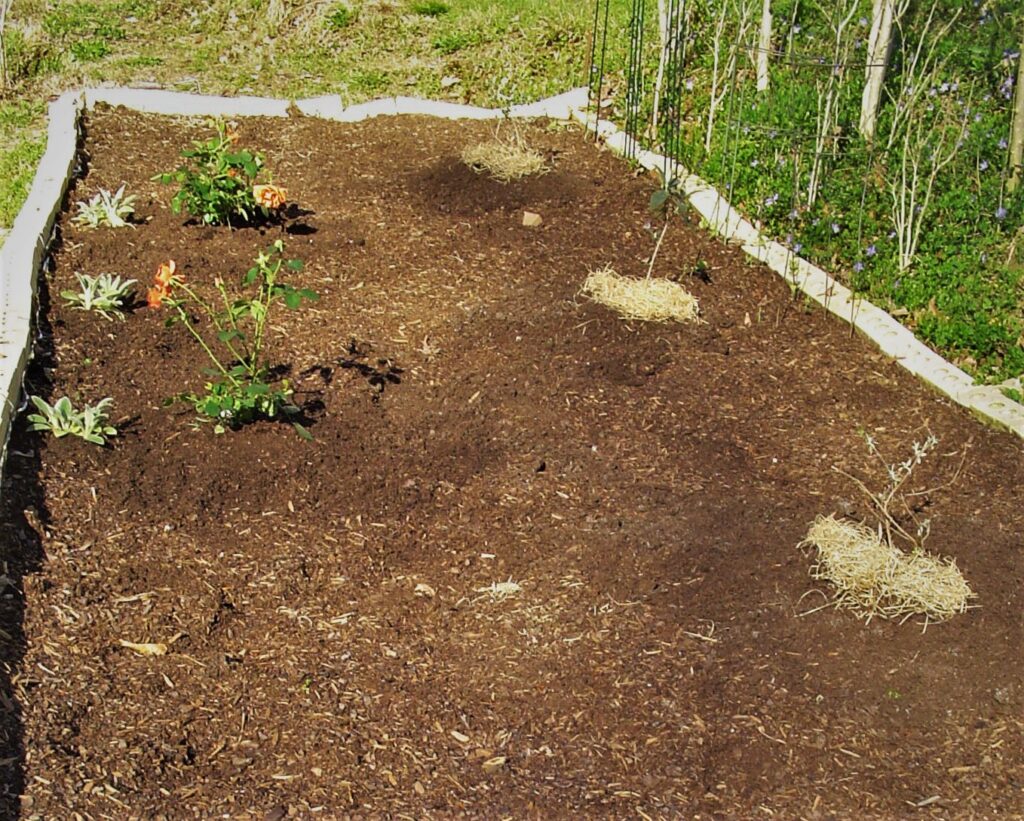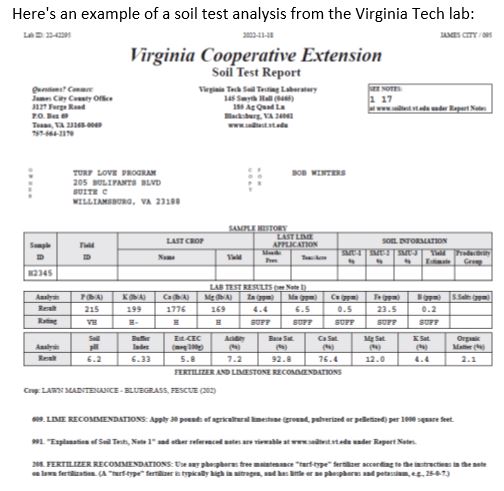Understanding Soil Testing and Colonial Soil and Water Conservation District Services

Take a soil sample for testing when starting a new garden or lawn area from scratch. It provides important information about soil amendments and nutrients your plants will need to thrive. Photo by E. L. McCoy
Soil Testing and Analysis
When we begin cultivating a new garden area, or want to improve our lawn, it is wise to begin with a soil test. Virginia Cooperative Extension labs analyze soil tests, for a small fee, and will send a comprehensive report to the individual who submitted the sample. There is a lot of useful information in the report once we know what to look for and how to use the data.
When you receive your soil sample results, it’s easy to get a little overwhelmed looking at all of the data presented. However, once we decipher these results, we can learn a lot of very valuable information about our soils and how to improve them so that we can grow more healthy lawns and gardens. In this article, we’ll look at how to interpret results from the Virginia Tech Soil Testing Lab, although the interpretation process is similar for other testing labs.
Here’s an example of a soil test analysis from the Virginia Tech lab:
Interpreting Soil Sample Results
For most homeowners and gardeners, the most important results included with this report are the macro-nutrient and micro-nutrient analyses, the soil pH, and the Organic Matter % if you chose to have that tested. Testing for organic matter content at the Virginia Tech lab requires an additional fee and you must indicate that you would like to add that test when you submit your soil sample information sheet to the lab. We’ll review the other analyses presented in this report, but typically the sections listed above are the ones we pay most attention to when looking at lawn and garden soil samples.
For most residential lawn and garden soil samples, many of the boxes within the Sample History table will be blank, as shown in the example. The Sample ID you provided the lab should be listed in the first box, and if you provided any information about previous lime applications that information would be included in the “Last Lime Application” boxes.
Lab Test Results
The second table, under the heading “Lab Test Results” presents the results for the macro- and micro- nutrients routinely analyzed by the lab. Notice that the macro nutrients, Phosphorous (P), Potassium (K), Calcium (Ca), and Magnesium (Mg), use a rating scale to indicate relative levels of each nutrient found in the sample. This scale includes Low, Medium, High, and Very High ratings. If necessary, “+ and –” signs may be included with a rating score to further refine the rating.
The micro-nutrients, Zinc (Zn), Manganese (Mn), Copper (Cu), Iron (Fe), and Boron (B), are reported on a sufficiency scale, meaning they will be listed as either sufficient (SUFF) or deficient (DEF). When you’re trying to decide how much fertilizer to apply based on these ratings, keep the following in mind: “When soils test low, plants almost always respond to fertilizer. When soils test medium, plants sometimes respond to fertilizer and a moderate amount of fertilizer is typically recommended to maintain fertility. When soils test high to very high, plants usually do not respond to fertilizer” (Virginia Cooperative Extension Soil Test Note #1).

It is wise to get a soil test analysis before adding amendments to a garden bed to avoid over use of fertilizers. Photo by E. L. McCoy
A Deeper Dive on Soil Chemistry
The final table includes results for the Soil pH, Buffer Index, Estimated Cation Exchange Capacity (CEC), Acidity, Base Saturation, Calcium Saturation, Magnesium Saturation, Potassium Saturation, and Organic Matter if that test was requested. For the average home lawn or garden, the most important of these results are the Soil pH and the Organic Matter. The Soil pH is a measure of the hydrogen ion content of a soil and is one of the most important results soil tests provide. The Soil pH will determine the plant availability, or how readily a plant can take up and use, nutrients already present in the soil. If the Soil pH is too high or too low, some nutrients may be unavailable to the plant or may even become toxic to the plant. If the nutrients are unavailable to the plant due to the pH, you may think that there’s a nutrient deficiency and over-apply fertilizers, but in reality the nutrients are already present in the soil but the plant cannot use them. For most lawns and gardens, a pH of 6.2 – 6.4 is preferred, although the required pH will be dependent on the type of plant being grown in the sample area.
The Buffer Index
The Buffer Index result measures the soil’s ability to resist changes in pH, which is crucial when making lime recommendations. As explained by the Virginia Cooperative Extension Soil Test Note #1, “a sandy soil and a clayey soil can have the same soil pH; however, the clayey soil will have greater reserve acidity (and a lower Buffer Index) as compared to the sandy soil, and the clayey soil will require a greater quantity of lime to be applied in order to raise the soil pH the same amount as the sandy soil.” The CEC of a soil measures the soil’s ability to hold on to nutrients that may otherwise be lost to leaching. The Acidity, Base Saturation, Calcium Saturation, Magnesium Saturation, and Potassium Saturation are all measurements associated with the CEC. Lastly, the Organic Matter test measures the percentage by weight of organic materials present in the soil. If an increase in organic matter is desired, additions of compost are often recommended.
Soil Amendment Recommendations
The final section of the soil test report includes recommendations from the lab to enhance the soil to maximize yields and growth potential for whatever plant you’re trying to grow. If needed, lime recommendations will be provided here, as well as fertilizer recommendations. The VT Soil Testing Lab also often references several publications, referred to as Report Notes, which can be found online. Look under Report Notes. Find additional information at: VCE Explanation of Soil Tests.
CSWCD Services Related to Soil Testing and Erosion Control Counseling
Turf Love
The Colonial Soil and Water Conservation District (CSWCD) offers several programs that can provide soil testing and erosion control assistance to landowners. The first of these programs is called Turf Love, which focuses on educating homeowners about the importance of environmentally-friendly lawn care. This program is offered in partnership with the James City County-Williamsburg Master Gardeners, who collect soil samples for Turf Love participants during site visits. The results of these samples are then interpreted by CSWCD staff who use the results, as well as data collected by the Master Gardener during the site visit, to prepare a nutrient management plan for the homeowner. This plan will provide direct instructions to the homeowner about how and when to fertilize their lawn, recommendations for appropriate products, and total amounts of a given product to be applied throughout the growing season. Lime recommendations will also be included if necessary. Find more information about Turf Love.
Virginia Conservation Assistance Program
The CSWCD also offers the Virginia Conservation Assistance Program (VCAP), which assists landowners with managing stormwater and erosion issues on their properties. By participating in VCAP, landowners receive technical assistance from a CSWCD staff member to identify and correct stormwater and/or erosion issues. Along with this technical assistance, VCAP can also provide financial assistance for the installation of eligible best management practices, or BMPs, that are often used to control or mitigate stormwater and erosion issues. Examples of these practices include rain gardens, rain barrels, dry wells, swales, and permeable pavement, among others. Homeowners, schools, businesses, houses of worship, and public landowners are all eligible for this program. Find more information, on the CSWCD website or call the office at 757-645-4895.
The Shoreline Evaluation Program
The CSWCD has also partnered with the James City County-Williamsburg Master Gardeners to offer the Shoreline Evaluation Program (SEP), which focuses on assessing erosion and water quality threats on tidal shore front properties. By participating in the SEP, shore front property owners will receive a site visit to their property with a team of District staff and Master Gardener volunteers, who will assess current or potential threats to the property and identify opportunities to help improve water quality. The assessment will include a visual inspection of the shoreline for signs of erosion or soil loss, invasive species, lack of vegetation, etc. If the property includes a managed turfgrass lawn, a soil sample will also be taken so that a nutrient management plan can be provided. After the site visit, the participant will receive a written report detailing the results of the assessment and any suggestions for shoreline improvement. Find more information about the Shoreline Evaluation Program.



